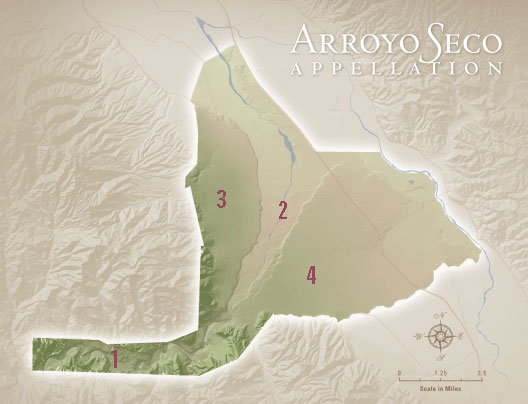Authored by many of California's pioneering "families of wine", the Arroyo Seco AVA is a section of terrain unified around the unique aspects of a seasonal creek - named "Arroyo Seco" - which brings rain water and snowmelt from the Santa Lucia Mountains to the Salinas Valley. Within the landscape that makes up the AVA there are many distinct pockets of geography that contribute to varied growing conditions. These aspects allow for a broad array of varietals to thrive in such a small appellation. Further, such varied geography combines to make the Arroyo Seco AVA one of California's most complex and diverse places to grow grapes.
The "Arroyo Seco" waterway, which fathers and unifies the appellation, accounts for the starting point of the AVA's western border and in a sense gives the Arroyo Seco AVA an West-East orientation. As one moves to the east, towards the exposed, North-South Salinas Valley the appellation fans out to encompass a wider section of land. Within this broader section of landscape, the terrain varies drastically and has multiple definable geographic features.
From west-to-east, the AVA features four general and visible areas of terrain - loosely referred to by local grape-growers as: (1) the "Gorge", (2) the "Ancient Riverbed", which cut (3) the "Western Bench" and (4) the "Southern Benchland". Each one of these general locations has various reasons why they are naturally self-limiting and ideal areas to grow complex and expressive wine grapes:
(1) The "Gorge" - this narrow ravine is protected from the direct marine-influences of the Pacific Ocean (and the southerly gale winds that plague the exposed, eastern segment of the appellation). That said, fog from the Pacific Ocean does penetrate the landscape and further the terrain is hampered by a strong easterly wind. Due to the dramatic rise of the mountains as well as millenniums of erosion, the soils are very shallow with a thin, rocky (shale-based) layer of topsoil. Furthermore, there is little flat, easily farm-able acreage and thus the steep terrain of the Santa Lucia Mountains constitute that vineyards be planted predominantly in mountainside locales. This portion of the AVA accounts for the area's highest elevations.
(2) The "Ancient Riverbed" - following the seasonal creek, this fanned landscape is bifurcated by benches (which the waterway cut) on either side as it heads towards the northern boundary of the AVA. Further, this section of terrain is directly exposed to the strong maritime influences that plague the Salinas Valley - an "open throat" valley which extends from the deep, cold waters of the Pacific Ocean. Due to its location, this portion of terrain experiences dense fogs and howling winds. It is further distinguished by meager soil conditions; river rocks litter the sandy surface-soil while dense, hardpan lens rests just feet below ground and promote root stress.
(3) The "Western Bench" - this portion of the appellation is visually defined by a 40-foot palisade that rises vertically from the "Ancient Riverbed" section on the western, mountainside of the AVA. Adjacent to the Santa Lucia Highlands AVA and overlooking the riverbed, the bench experiences the extreme marine-influences of the deep, cold waters from the Pacific Ocean at Monterey Bay. Fog saturates the landscape during the summer, ripening months and gale-force winds rack vineyard sites. Additionally, the western bench feature hillside like conditions whereby roots struggle to find water and thus further limit tonnage yields.
(4) The "Southern Benchland" - the bench and terrain located on the southern side of the riverbed which extends out south and east to the boarder of the appellation. This landscape features somewhat more fertile soil, yet the potential farming benefits are negated by converging winds; as the easterly wind from the "Gorge" combine with the southerly howlers from the Pacific Ocean. In addition to converging winds, the terrain is also the base of another smaller waterway - named "Reliz Creek" - and millenniums of erosion have covered this plain with a dichotomy of river-rock (shale and granite) in-and-among the topsoil.
All-in-all, each specific portion of terrain within the appellation features varying yet innately, self-limiting growing factors which in concert create a truly unique, complex and diverse American Viticultural Area (AVA).

